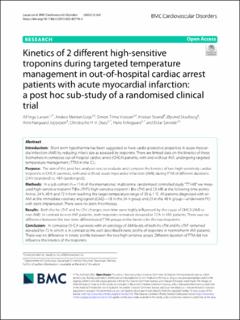Kinetics of 2 different high-sensitive troponins during targeted temperature management in out-of-hospital cardiac arrest patients with acute myocardial infarction: a post hoc sub-study of a randomised clinical trial
Larsen, Alf Inge; Grejs, Anders Morten; Vistisen, Simon Tilma; Strand, Kristian; Skadberg, Øyvind; Jeppesen, Anni Nørgaard; Duez, Christophe H. V.; Kirkegaard, Hans; Søreide, Eldar
Journal article, Peer reviewed
Published version

Åpne
Permanent lenke
https://hdl.handle.net/11250/3040260Utgivelsesdato
2022Metadata
Vis full innførselSamlinger
- Department of Clinical Science [2317]
- Registrations from Cristin [9766]
Sammendrag
Introduction
Short term hypothermia has been suggested to have cardio protective properties in acute myocardial infarction (AMI) by reducing infarct size as assessed by troponins. There are limited data on the kinetics of these biomarkers in comatose out-of-hospital cardiac arrest (OHCA) patients, with and without AMI, undergoing targeted temperature management (TTM) in the ICU.
Purpose
The aim of this post hoc analyses was to evaluate and compare the kinetics of two high-sensitivity cardiac troponins in OHCA survivors, with and without acute myocardial infarction (AMI), during TTM of different durations [24 h (standard) vs. 48 h (prolonged)].
Methods
In a sub-cohort (n = 114) of the international, multicentre, randomized controlled study “TTH48” we measured high-sensitive troponin T (hs-cTnT), high-sensitive troponin I (hs-cTnI) and CK-MB at the following time points: Arrival, 24 h, 48 h and 72 h from reaching the target temperature range of 33 ± 1 °C. All patients diagnosed with an AMI at the immediate coronary angiogram (CAG)—18 in the 24-h group and 25 in the 48-h group—underwent PCI with stent implantation. There were no stent thromboses.
Results
Both the hs-cTnT and hs-cTnI changes over time were highly influenced by the cause of OHCA (AMI vs. non-AMI). In contrast to non-AMI patients, both troponins remained elevated at 72 h in AMI patients. There was no difference between the two time-differentiated TTM groups in the kinetics for the two troponins.
Conclusion
In comatose OHCA survivors with an aetiology of AMI levels of both hs-cTnI and hs-cTnT remained elevated for 72 h, which is in contrast to the well-described kinetic profile of troponins in normotherm AMI patients. There was no difference in kinetic profile between the two high sensitive assays. Different duration of TTM did not influence the kinetics of the troponins.
